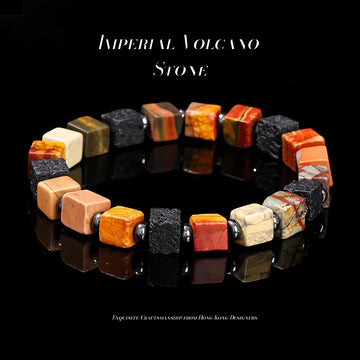When men choose stone bracelets, the color matching should revolve around three core elements: personal skin tone, style positioning, and wearing scenarios. The following are specific matching strategies and tips to avoid pitfalls:
First, the underlying logic of color tone matching
Skin color matching principle
Cold white skin: It is suitable for dark tones (such as obsidian and deep blue lapis lazuli), highlighting the temperament through strong contrast and avoiding light colors that make the skin look pale.
Warm yellowish skin: Warm tones (such as red agate and yellow tiger's eye) are recommended, which can brighten the complexion and enhance affinity. Be cautious when choosing cool shades of grayish blue.
Bronze/wheat color: You can try the contrast of warm and cool colors (such as obsidian + red agate), which complement the tough look with the skin tone.
Style and scene mapping
For business occasions: Matte obsidian, dark brown sandalwood and other single-color options are low-key and stable, avoiding bright colors or complex patterns.
For casual occasions: You can try aging techniques (such as copper rust-like metal paired with tiger's eye) or high-saturation color contrasts (such as red and black) to showcase your personality.
Cultural occasions: Pairing grayish-white jade (such as Hetian jade) with traditional patterns conveys an Oriental charm. Avoid materials with fluorescent colors or overly metallic textures.
Second, the classic color tone combination scheme
"Cold and stern business style"
Main color tones: Pure black (obsidian), dark gray (grey agate)
Embellishment suggestions: matte silver clasp, a few white patterns (such as obsidian rainbow eyes)
Applicable scenarios: Formal meetings, business banquets
"Hardcore street style"
Main color tones: Obsidian + red agate (warm and cool contrast colors)
Design details: Open bracelet, decorated with metal rivets
Matching tips: Create a visual impact with dark-colored clothing such as black, gray, and military green
"Retro Cultural Flow"
Main color tones: grayish white (Hetian jade), brownish yellow (sandalwood)
Pattern selection: meander pattern, cloud pattern, ancient carving method
Tip to avoid pitfalls: Be cautious when choosing overly bright murals or metal inlays with a strong modern feel
"Natural Zen School"
Main color: turquoise + coconut shell (blue-green + brown)
Material combination: Natural stone + woven rope
Applicable scenarios: yoga, meditation, outdoor activities
Third, matching skills and pitfalls avoidance guidelines
The rule of distinguishing primary from secondary
For single-color bracelets, attention should be paid to the texture of the material (for example, when choosing obsidian, pick the one with rich rainbow eyes to avoid the monotony of pure black).
For multi-color bracelets, the main color tone should be clearly defined (such as red agate as the main color and obsidian as the secondary color) to avoid overly mixed colors that may appear cheap.
The philosophy of warmth and coolness embellished with metal
Silver jewelry: Suitable for cool tones (obsidian, blue sandstone), enhancing a futuristic feel.
Copper ornaments: Suitable for warm tones (red agate, beeswax), creating a retro atmosphere.
Avoid pitfalls: The gold plating layer is prone to fading. It is preferred to choose 925 silver or titanium steel materials.
Skin color testing techniques
Before shopping online, you can compare your skin color with a color card or try on accessories of similar tones (such as watch straps or ties).
When trying it on offline, you can observe the contrast effect between the bracelet and the skin color on the inner side of your wrist.
Lightning protection list
Fluorescent colors: Men should choose with caution (such as bright green and bright pink), as they may appear cheap.
Excessive color blocking: Avoid using more than three colors, otherwise it may appear overly flamboyant.
Cheap techniques: such as plastic-like resin, dyed stone (which is prone to color fading when wiped with alcohol).
Fourth, advanced matching formulas
"Cold and warm hedging"
Formula: Cold-colored stone (Obsidian) + warm-colored embellishment (red agate)
Obsidian bracelets with red agate beads are perfect for pairing with dark-colored clothes in autumn and winter.
"Material mix and match"
Formula: Stone + Metal + natural materials
Tiger's eye + titanium steel chain + coconut shell rope, suitable for outdoor sports scenarios.
"Cultural symbol"
Formula: Traditional patterns + single-color stone
The Hetian jade loop bracelet with a silver clasp conveys the elegance of an Eastern gentleman.
Fifth, ultimate advice
Give priority to natural materials: The warm and mellow feel of natural stone is more in line with a man's temperament. Avoid artificial synthetic or dyed materials.
Pay attention to the details of the craftsmanship: Whether the polishing is smooth, whether the edges are round, and whether the inlaying is firm directly affect the texture of the bracelet.
Match personal style: Show taste through details rather than blindly pursuing trends. For instance, programmers can choose simple obsidian, while artists can try color-blocking designs.
By following the above strategies, men can precisely match the color tone of their stone bracelets with their personal charm, avoiding a "rushy" or "cheap" look due to improper matching.







